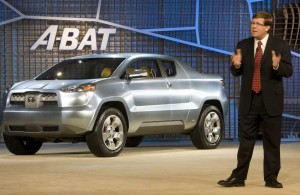Toyota expects to increase its already vast North American production network, a senior U.S. official revealed, adding niche products on top of the core vehicle lines that currently roll off an assortment of assembly lines in the U.S., Canada and Mexico.
The move comes as Toyota struggles to adapt to a changing world in which exchange rates now – and for the foreseeable future – make it increasingly costly to import vehicles from the home market, said Toyota’s top American executive, Jim Lentz. Complicating matters, Toyota, like its competitors, have come to recognize how vulnerable Japanese operations are to disasters like the devastating earthquake and tsunami that struck the island nation in March 2011.
But Toyota officials stress they will not completely abandon the company’s home base.
During a speech at the annual Management Briefing Seminars, in Traverse City, MI, Lentz declined to provide much detail, only noting that, “We’ll have additional announcements down the road as more of cars are designed, built, sold and serviced right here in North America.”
But few observers appear to be surprised by the news. Toyota has been increasingly dependent on a North American manufacturing base since it first got its toes wet partnering with General Motors in 1984 at the NUMMI joint venture in Fremont, California.
Since then, it has added more than a dozen assembly and component plants that now account for the majority of vehicles sold under the Toyota brand in the U.S.
The company has also rapidly expanded its production bases in other key markets, including Europe and China, as sales in those regions grow.
Accompanying the increase in manufacturing, Toyota has also been amping up the capabilities of its regional design and engineering centers, such as the CALTY styling studio near Los Angeles and its R&D center near Ann Arbor, Michigan.
In all, Toyota has announced plans to add 3,500 jobs in North America this year alone, backing that up with capital investments expected to top $1.6 billion.
Exchange rates have played a critical role in the strategy. Though the dollar has recovered somewhat in recent months, it dropped in value to barely 80 yen this year. By comparison, when the NUMMI plant was first opened the exchange rate was around 250 yen to the dollar. And analysts say Toyota and its Japanese rivals have trouble financially justifying Japanese-made imports to the U.S. at much less than 90 yen.
But there are other factors influencing the maker’s shift in manufacturing strategy.
The March 2011 earthquake and tsunami showed how vulnerable a tiny set of islands in the Pacific can be to natural forces. The northeast region struck by the disaster was a manufacturing center responsible for many of the parts and components used by the auto industry and when the region was struck virtually all Japanese automotive assembly plants were soon idled. Even foreign production was influenced by the shortages.
Since then, a variety of makers, including Nissan and Honda, have expressed the need to further diversify they production and sourcing to reduce the potential impact of any future natural disaster.
Toyota has also faced other pressures, however. The safety scandal that enmeshed the Japanese giant in 2009 and 2010 forced it to rethink its reliance on strong central management. Under pressure from President Akio Toyoda – grandson of the maker’s founder – Toyota has begun expanding regional autonomy and that is translating into more localized products and production.
The 2013 Toyota Avalon sedan was all but entirely developed in the U.S., and the seemingly successful program is expected to encourage others to follow that path.
Despite such moves, President Toyoda has repeatedly asserted that his company, a flagship of Japanese manufacturing prowess, won’t entirely abandon the homeland. Some production will always remain there, he has said repeatedly during the last year – though exactly how much hasn’t been detailed.
According to Lentz, the latest thinking will still focus primarily on mainstream products and those primarily targeted at the U.S., like the Tundra pickup and the Avalon. But some higher-volume niche products, such as those from the Lexus luxury brand, will now be shifted to North American assembly lines.
He wouldn’t confirm whether the Prius hybrid would also shift to this side of the Pacific. That has been a matter of ongoing debate within Toyota – the company initially announcing U.S. production plans four years ago but subsequently deciding to stick with Japan.

